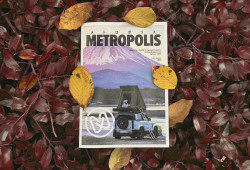
Originally published on metropolis.co.jp on December 2010

2010年 今年の漢字® 主催・写真提供:(財)日本漢字能力検定協会
Year of the Heat
It’s official: 2010 was hot. In the Japan Kanji Aptitude Foundation’s annual poll, a whopping 14,537 out of 285,406 respondents nominated the kanji for atsui as the character that best represented 2010 . The main reason was, of course, the record-breaking heat waves that swept across Japan this summer, causing epidemics of heatstroke as well as affecting produce prices. Respondents also cited the Chilean miners’ safe rescue from the “hot” depths of the earth, as well as the “heat” of the Hayabusa space craft. One voter explained, “It was really abnormally hot this summer. Vegetables were very expensive, and it was impossible to live without the air conditioner, so our household finances took a big hit.” Sarah Cortina
Key
Highlights
Lowlights
Art
![]()
Local color

Top: Courtesy of the Watarium Museum
Bottom: Courtesy of the Setagaya Art Museum
While failing to live up to expectations leaves a bitter taste in the mouth, exceeding them creates a buzz. Case in point: “Future Visions—Forest, Cloud, Mountain” by the architect Sousuke Fujimoto at the Watari-um. This pokey little museum, with three floors connected by a single, slow elevator, is one of my least favorite venues in Tokyo. Also, architecture usually doesn’t translate well to exhibitions. Yet Fujimoto’s approach was exciting—he turned the separation of the floors into an asset, with the elevator ride providing “punctuation” between three distinct and differently scaled display areas. These included a life-sized transparent cave; a forest of small architectural models on long bendy rods that undulated all around visitors like flowers in a jungle; and a miniature city of the future that made you feel like Godzilla. In this vivid and visceral show, Fujimoto communicated his passion for architecture. C.B. Liddell
![]()
The toothless smile
This might come as a bit of a shock, but my artistic low of the year involved an exhibition that featured the likes of Degas, Van Gogh, Gauguin, Giacometti, Klee, Kandinsky, Braque, Picasso, and several other giants of modern art. The trouble with “Masterpieces From the Winterthur Collection” at the Setagaya Art Museum was that it bit off more than it could chew, and ended up grinning at visitors with an ugly, toothless smile. An effort to get as many big names as possible on the bill—no doubt to attract punters—meant that most of the works were third rate and only distinguished by their signatures. The inclusion of too many genres and styles also meant that the show had no sense of unity or focal point—rather like an art remote control set on “Surf.” CBL
Music
![]()
Sunny folk

Top: Courtesy of Contrarede
Sometimes, songs stay in your head because they’re annoyingly catchy. Other times, it’s because they’re just that good. The music on folk-pop Svengali Shugo Tokumaru’s Port Entropy definitely belongs to the latter category. Part of a worldwide coterie of neo-folkies that also includes Grizzly Bear and Sufjan Stevens, the unassuming Tokumaru continued to up his game on his fifth album. The disc features quirky tales of elevators and drive-thrus on instruments ranging from the glockenspiel to the harpsichord, all of which Tokumaru plays himself. When the musician is in his upbeat, Beatles-influenced vein (“Tracking Elevator,” “Rum Hee”), his melodies can bring a smile to even the most jaded of lips. Before writing this, I revisited the album to see if it still stood out six months since its release—now those whimsical, fantastical songs are whirling around my head all over again. Dan Grunebaum
![]()
Sayonara summer
Years before Fuji Rock and Summer Sonic, there was the Tokyo Summer Festival. Founded over drinks in 1985 by pianist Kyoko Edo, composer Maki Ishii and musicologist Tashi Funayama, TSF was a gloriously noncommercial smorgasbord of concerts that sprawled over Tokyo for one month each year. It was also the only Japanese music festival founded not by promoters but by musicians. With dreamy themes like “Music, Exoticism and Orientalism” and “Forest Echoes/Desert Voices,” the event featured appearances by international world music figures like Senegalese superstar Youssou N’Dour (pictured). There were also countless unknown yet striking musicians from places as disparate as Zanzibar and Xinjiang—not to mention obscure Japanese performers like blind priests from Kyushu and nonagenarian singers from the Ryukyu islands. TSF hosted many magical moments: my personal favorite was receiving a tribal ink tattoo in the mountains of Okutama from Karaja Amazon Indians before dancing with them and robed Saharan Tuareg balladeers around a fire circle in what must have been Japan’s strangest double bill ever. But all good things must end, and after 25 seasons, the Tokyo Summer Festival sounded its last refrain in 2009. Without the leadership of an aging Edo, promoter Arion-Edo was apparently no longer able to persuade sponsor Mitsui Fudosan to back the event. DG
Multimedia
![]()
Twitter conquers all

Top: ©2010 Konami Digital Entertainment
Although Twitter was first launched in 2006, this was the year that the SNS truly burst onto the Japanese scene. Its success helped unleash an explosion of interest in related services and apps, from video streaming sites like Ustream and Twitcasting to coupon aggregator Twiwari and Tweegle (which disguises your timeline as a Google search page for stealthy browsing). This year also saw several international coups by Japanese users. In July, Yakult Swallows fan @GGGGGGo_Lets_Go achieved the honor of posting the SNS’s 20 billionth tweet. And while Mixi and Gree still hold the top spots at over 20 million users apiece, information site Biglobe recently released a report revealing that Japanese users posted a total of 360,653,206 tsubuyaki in November alone. But the award for Best Twitter Moment of 2010 goes to user @naika_tei, who on May 5 tweeted a desperate plea for toilet paper from the 3F bathroom of the Yodobashi-Akiba store. A mere 20 minutes and nearly a hundred retweets later, help arrived. SC
![]()
No love for Love Plus
When it first went on sale at the end of 2009, Love Plus was a game-changer in the world of dating simulators. Such games usually end when the girl confesses her feelings; Love Plus is essentially endless, allowing players a nearly infinite number of dates and interactions with not one, but three characters. The iPhone version, released in April, combines AR technology with the iPhone’s camera to let users take photos of themselves “with” their girlfriends. The charmingly named sequel Love Plus+, released in June, went even further: players could take a trip to Atami, with resorts in the seaside town offering romantic getaways for “two” aimed at users and their virtual girlfriends. Well, moaned the media pundits, no wonder the birthrate is falling so catastrophically! It’s bad enough that Japan has become a nation of soshoku danshi, with men more interest in fashion and skincare than romance. But with the surging popularity of games like Love Plus, even guys who are interested in romance have become incapable of engaging in real-world relationships. The furor sparked media interest around the globe, with everyone from the Huffington Post to CNN picking up the overblown sob story. SC
Books
![]()
The E-Book Evolves, Slightly

Top: Photo by James Hadfield
This is the country that gave us the cellphone novel, but Japanese readers—and publishers—have taken a while to warm to more recent iterations of the e-book. While other countries were rushing to embrace the Kindle and its ilk, consumers here seemed content with plain old paper, leading LDP lawmaker Hiroshige Seko to caution that “Japan should not become another Galapagos Islands.” So it was hard not to titter when Sharp launched its new book, magazine and newspaper reader a few weeks back. The name: Galapagos. Cynicism aside, this has been a promising year for e-books in Japan, helped along by the success of Apple’s iPad. Sharp’s device hit the market on the same day as the Kindle-esque Sony Reader, which has already been doing ho-hum business in overseas markets. Lest we forget, Sony launched an unsuccessful reader here back in 2004; the difference now is that more publishers seem eager to play ball. Well, sort of. In February, over 30 of the big dogs joined forces to form the Electronic Book Publishers Association of Japan. A promising first step, you’d think, but their only major action since then has been to throw a hissy fit when Sony teamed up with KDDI, Toppan Printing and the Asahi Shimbun Company to start an e-book distribution platform without asking them first. The future may be bright, but we aren’t quite there yet. James Hadfield
![]()
Historian Goes Bombastic
Publisher Henry Holt and Company seemed to have a hit on their hands with The Last Train from Hiroshima, Charles Pellegrino’s visceral account of the aftermath of the atomic blast. When it was released in January, the book was praised by The New York Times as a “gleaming, popular wartime history, John Hersey infused with Richard Preston and a fleck of Michael Crichton,” while James Cameron quickly snapped up the film rights. But then doubts began to emerge: one of Pellegrino’s interview subjects turned out to have lied about being on a plane that accompanied the Enola Gay, while other historians questioned if two priests mentioned in the text had ever even existed. Oh, and the PhD which the author claimed to hold? Apparently that was suspect, too. Unsatisfied with Pellegrino’s responses to its concerns, Henry Holt pulled the book from publication, but the historian remains defiant. Claiming to have been the victim of a “smear campaign,” he’s currently working on a revised edition. Good luck finding a publisher, Charles. JH
Entertainment
![]()
Tabloid heyday

Bottom: ©OCEANIC PRESERVATION SOCIETY. ALL RIGHTS RESERVED.
The year was full of marriages, divorces, scandals and amorous couples on Japan’s celebrity scene. No one got more coverage in the media than scandal magnet Erika Sawajiri, 24. After feuding with media and getting the boot from the film Space Battleship Yamato, she dropped out of sight, heading overseas. The actress reemerged in April to announce she was ending her marriage and that certain questions were off-limits at press conferences. Then came a triumphant comeback with a sizzling performance at the Girls Award 2010 fashion event, followed by a sexy 24-page spread in Glamorous magazine, in which she spoke candidly about her attitude toward the media and rumors of her drug use. By the end of summer, Sawajiri had dropped out of sight again, canceling a scheduled appearance at a hair-care product launch due to an “unspecified illness.” The tabloid media were quick to suggest that we may be seeing a return of Sawajiri’s “difficult” behavior. Chris Betros
![]()
Day of the Dolphin
When The Cove won the Academy Award for best documentary in February, the Wakayama town of Taiji started battening down the hatches for the onslaught of PR against its annual dolphin hunt, at which the film and its protagonist Rick O’Barry take aim. Rightwingers harassed the film’s distributor for many weeks to block the release of the film. When it was finally shown, nationalists picketed theaters to try and scare away audiences. Former Flipper trainer O’Barry, who won’t be on the Taiji mayor’s Christmas card list, made a few unwelcome visits to the town, which finally agreed to sit down with anti-dolphin activists in November. Predictably, the acrimonious meeting ended without reaching any agreement. CB
Film
![]()
First time’s a charm

Top: ©2009 Zero Pictures
It’s not often that we get to hail the emergence of a Japanese film auteur who, from their very first film, seems destined for greatness. One has to look back to 1995 and Hirokazu Koreeda’s stunning Maboroshi no Hikari for a Japanese director with a debut film as sensitive and accomplished as Momoko Ando’s Kakera (“A Piece of our Life”). The story has the added twist that Ando is the scion of a famous artistic family: her father is the revered actor/filmmaker Eiji Okuda, her mother is the essayist Kazu Ando, and her younger sister the fast-rising actress Sakura Ando. Momoko studied sculpture and painting in London and filmmaking in New York. She lived in the former for more than five years, and her art has clearly taken on some of the European delicacy and attention to emotional states that is often lost in Japanese film. Kakera is a tender romance/coming-of-age story as well as an excruciating look at someone past their prime and desperate for love. As with other films by directors who studied painting (like Peter Greenaway), Ando’s frames have an acute visual sense. We can only hope that this is the harbinger of great things to come. Rob Schwartz
![]()
International discord
Although film has been called “the international language,” 2010 proved the industry is not immune to political spats. At the Tokyo International Film Festival in October, fans of popular Taiwanese actress Vivian Hsu anxiously awaited her appearance during the opening ceremony, only to be disappointed when she and the cast and crew of six Taiwanese films failed to turn up. The rumor was that the boycott was due to the Chinese delegation insisting the Taiwanese guests be introduced as from “Chinese Taipei.” At a Q&A for the film Juliets, director Hou Chi-jan dismissed the controversy, saying, “We are already part of one country, a country called film.” The Taiwanese filmmaker then burst into tears. Meanwhile, a press conference scheduled for the cast and crew of The Piano in a Factory (pictured) and other Chinese films was abruptly canceled, citing security concerns in light of recent demonstrations outside of the Chinese embassy in Tokyo. In a less serious incident of international tension, Japanese producer Toshihiro Kitta, who specializes in Japanese-Korean co-productions, noted one point on which the two countries cannot agree—Japanese actors don’t mind cold rice with their bento on the film set, but the Koreans insist on hot rice and kimchi. Can’t we all just get along? Kevin Mcgue
Sports
![]()
Top of the world

Have you noticed how the local media becomes awfully quiet when an athlete from Japan goes abroad and fails to be an instant success? The guy/girl is never mentioned. Currently, useless fullback Yuto Nagatomo gets the bulk of the overseas soccer coverage, as he’s managed to con his way into a crap Italian team (while a top player in the US—Kosuke Kimura—who helped his team win the MLS Cup in November is virtually unknown in his homeland). In golf, Ryo Ishikawa took his time finding his feet as a pro, and the media here largely ignored him until he proved to them he wasn’t going to be an embarrassment. After that, it was open season on the super-talented teen. On the women’s side, Ai Miyazato burst onto the scene as a schoolgirl, swept all (almost) before her in Japan while she was still a teenager, and headed into apparent obscurity in the US. Ai-chan took her time readjusting to life on the LPGA Tour and, after failing to dominate like she did in Japan, the media moved on to other good-looking women golfers (hello, Momoko Ueda!). In fact, it took Ai-chan (pictured) more than three years to win her first LPGA tournament. But she’d paid her dues and was in a position to compete. She collected five victories in 2010 and became the No. 1-ranked golfer in the world. Now, of course, the media’s all over her again. Fred Varcoe
![]()
Sumo’s big bust
You have to wonder just how many mistakes a sport can make, even in a land where athletic organizations—and many teams—are generally run by incompetent corporate drones and retired pensioners whose vision of success is either how much money they’ve saved, how much money they’ve made, or what overstuffed title they’ve awarded themselves. Backed by a government that often seems totally out of touch with reality, it’s more of a surprise that other sports don’t suffer the ignominy that has befallen sumo. The retirement of Asashoryu (pictured) was understandable in purist terms—he wasn’t really what a yokozuna is meant to be—but in terms of pragmatism, sport even, it was an act of such comic buffoonery, it made The Three Stooges look like The Godfather. Even if you overlooked the hazing death of a wrestler, the drug scandals, the betting scandals, the organizational scandals (i.e., the attempted freezing-out of ex-yokozuna Takanohana), and the incompetence and leadership failures, kicking out the one star who was keeping the sport together amounts to professional suicide. No wonder Hakuho cried when he heard the news. He himself was turned into a joke figure, chasing hollow records in a sporting vacuum before ever-dwindling crowds. FV
Clubbing
![]()
Micro Clubbing

Top: Courtesy of Paradigm
Jeff Mills, Derrick May, Matthew Herbert and Four Tet have all played there. The club has welcomed special guests like Ryuichi Sakamoto. And it’s roughly the size of your apartment. We’ve seen some high-profile club openings and closures this year, sure, but the most exciting developments in Tokyo dance culture have been taking place in tiny spaces such as Dommune. This basement studio on the way from Shibuya to Nishi-Azabu hosts evening talk sessions and DJ sets, which are broadcast live over the internet via Ustream. There’s only space for 50 people inside, but the online audience is far larger: since opening in March, Dommune has become one of the most popular Ustream channels in Japan, clocking up nearly 4 million views to date. This micro-club sensation is the work of Naohiro Ukawa, VJ, contemporary artist, graphic designer and “media rapist” extraordinaire. Scenesters might remember Ukawa’s earlier Mixrooffice, a sound-proofed office in Shibuya that hosted private parties with everyone from Juan Atkins to MIA. Dommune is every bit as teeny as its predecessor, but it’s the broadcast element that makes it so intriguing, pointing the way towards a future of atomized, virtual revelry where the only ticket you need to the party is an internet connection. Check www.dommune.com and @dommune on Twitter for details. JH
![]()
The Hip and the Dead
“Do you guys even know this song?” slurred Casey Spooner from his elevated perch in the DJ booth. Midway through a rendition of his group’s most famous track, “Emerge,” it was becoming obvious that the anticipated crowd singalong wasn’t going to materialize. Electroclash doyens Fischerspooner were once the toast of fashionable dancefloors from New York to Berlin, but their appearance at this year’s Fuji Rock Festival drew a reception every bit as soggy as the weather itself. For a group famed for the extravagance of their live shows, this was a pretty desultory affair, tinged with schadenfreude. Accompanied only by DJ Lauren Flax, Spooner (pictured) had the air of a deflated grande dame, giving drunken shout-outs to the audience then staggering away from the decks to let his more able accomplice do her thing. The show, such as it was, ended with him apologizing to the crowd for being so sloshed. Fashion idols: when they fall, they fall very hard indeed. JH
Food & Drink
![]()
The (re)birth of cool

Top: Courtesy of ANA Intercontinental Tokyo
Tokyo’s restaurants and nightclubs are renowned the world over, but only recently has anyone dared to combine their sensibilities in a single venue. The opening of Mixx at the ANA InterContinental Tokyo offers hope that the line separating cutting-edge cuisine and a dancefloor vibe will continue to erode—and that fine dining may finally move away from stuffy rooms, stiff servers and Muzak. The first shot in this battle was fired in spring 2007, when restaurant-lounge 57 debuted with upscale chophouse fare on the menu and an original house mix on the speakers. A few months later came the arrival of Peter at the Peninsula Tokyo hotel, a bona fide foodie destination whose bar is festooned with chrome “trees” and whose mohawked waitsaff prowl the room with attitude. Mixx (www.anaintercontinental-tokyo.jp), created by hotter-than-thou local designer Gwenaël Nicolas, features avant-garde cocktails—tomato juice with basil, pizza spices and espuma mozzarella, anyone?—and an atmosphere that’s equal part worldly hotel bar and sleek lounge. Long may it reign. Steve Trautlein
![]()
The race to the bottom
The year 2010 served as a reminder that too much of a good thing is not necessarily a good thing at all. The B-kyu trend, which started out as a recessionary craze for off-price yoshoku, has now taken hold of the city’s culinary scene. Sales of cup ramen are booming, and the cost of a Sukiya beef bowl has returned to pre-BSE levels. All across the city, upscale dining rooms are sitting empty, and the question among restaurateurs seems to be: who can offer belly-filling fare for the lowest price? While we applaud the idea of locals saving money on their food budget, we mourn for the chefs who have built their dreams on the assumption that Tokyoites would continue to enjoy interesting, high-quality cuisine. The most depressing sign of dining apocalypse: near where we live in Chinatown, a new breed of super-cheap all-you-can-eat restaurants has sprouted up, with obnoxious touts drumming up business on the street. “[They] are repeatedly violating the rules on manners,” a local restaurant executive complained to the Asahi last May. “If they carry on in this selfish way, the town won’t prosper.” Penny-pinching diners would only have themselves to blame. ST







